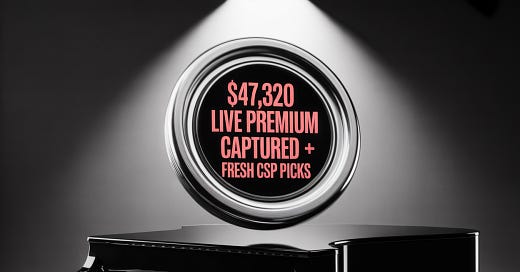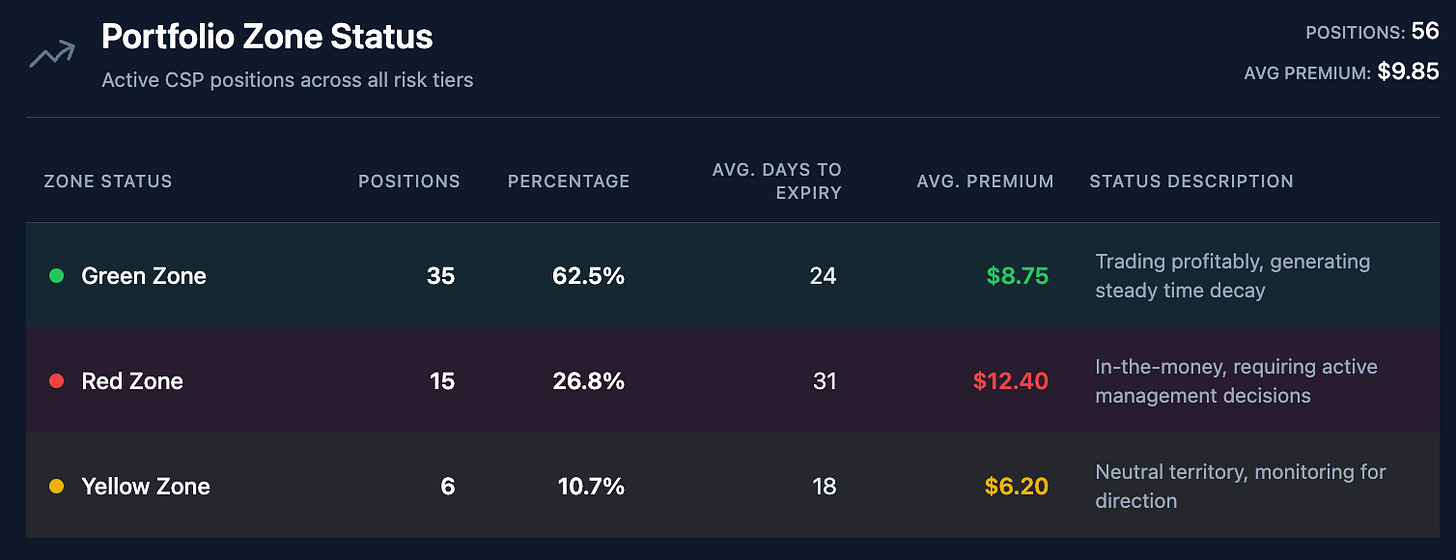$47,320 Captured in 90 Days: Stop Waiting for the Dip, Start Getting Paid (New CSP Picks Inside)
My live portfolio currently holds 56 active positions using this strategy, with 62.5% already profitable.
$47,320 captured in cash premium this quarter alone.
Please, stop waiting for the dip.
While you're hoping for a bargain, institutional traders are collecting cash. They're not timing the market, they're making the market pay them to wait.
Here's how: They see a stock like TSLA at $295. Instead of chasing it, they sell a put option at a lower price, say $280, and instantly collect a premium.
If the stock stays up, they keep the cash.
If it drops, they buy the shares at a discount.
Either way, they win.
This is the systematic alternative.
In this weekly issue, I’m going to break down the performance for you and, crucially, detail the management of the few positions that require attention.
Then, you'll see the new income opportunities my proprietary screen has found for this week.
If you're new here, welcome!
You're looking at my weekly update on my living, breathing Cash-Secured Put (CSP) portfolio. It’s built on a single powerful idea: generating consistent income by getting paid to buy the stocks we want at prices we choose.
In each issue, I’ll take you inside this portfolio to dissect every open cash-secured put under real market conditions. Then, we'll look forward, identifying the best new opportunities to generate immediate cash premium for the week ahead.
My goal is to hand you the institutional playbook for selling CSPs — from finding the right opportunities to managing every position from open to close.
II. Strategy Recap: The VADER Algo & The Live Trading Lab
Newcomers often ask what makes this approach so different.
It comes down to two core elements that, combined, create a learning environment and opportunity radar that is simply unparalleled.
You can think of it as a Ph.D.-level mentorship in practical options strategy.
For years, I used a proprietary tool on my trading desk called VADER.
It was developed with our team of quants as a ruthless elimination engine for our own internal use, to find the absolute best income opportunities in the market.
I took it home with me after I retired.
VADER stands for Volatility Arbitrage Dividend Enhancement Return system.
It puts the entire market through a three-stage institutional filter:
Viability: It first eliminates over 90% of stocks based on non-negotiable liquidity metrics and volatility, removing anything too risky or unpredictable.
Quality: It then runs the survivors through 16 tests, ensuring we only deal with fundamentally sound companies.
Opportunity: Finally, it ranks the elite few by their cash-secured put income potential and sorts them into Conservative, Balanced, and Aggressive tiers.
The result is the same thing I used on the desk: a curated list of the best CSP opportunities in the market, delivered into your inbox every Thursday.
But knowing what to trade is only half the battle.
The other half—where most traders fail—is knowing how to manage a trade. This is why I built this project as a live trading lab.
Instead of just giving you entry signals and wishing you luck, I track every single model trade from inception to conclusion.
I scan the market, build the trades I own/as if I owned them, and then publicly document every decision: the wins, the losses, the trades I roll to avoid assignment, the losing rolls I have to close, and the times I deliberately take assignment and turn around to sell calls against the new shares.
This creates a transparent, real-world learning environment where you can build trade-management "muscle memory" without risking your own capital.
Every Thursday, we do cash-secured put opportunities.
Every Sunday, we publish covered calls.
From my years mentoring traders, I've learned that in order to trade with consistency, you need to see how it’s done over and over again.
The Trading Lab lets you look over my shoulder, showing you how to find and manage trades systematically. It's the fastest way to build your "muscle memory" and confidence.
III. Performance Snapshot
So, what does this process look like in practice?
Let's examine our current portfolio performance and why these results matter for your income strategy.
Why This Distribution Is Actually Excellent News:
That 26.8% red zone percentage might seem concerning to new option traders, but it's exactly what you want to see from a systematic income strategy during elevated volatility periods.
Here's why:
First, the red zone doesn't mean "losing money" — it means we're facing potential assignment on stocks we predetermined we'd be happy to own at these strike prices.
Second, the 62.5% green zone rate demonstrates how VADER screening is working. We're generating consistent profits on the majority of positions while maintaining strict risk controls. In institutional trading, a 60%+ profitable position rate on premium collection strategies is considered excellent performance.
Third, our diversification across expiration cycles (July 18th and August 15th concentrations) provides natural risk management and roll flexibility. We're not concentrated in single expiration dates that could create forced decisions.
Revenue Generation Analysis:
The $47,320 in captured premium over the past quarter translates to approximately $15,773 in monthly income from our systematic approach.
More importantly, this income is front-loaded. Whether these positions expire worthless (ideal scenario) or result in assignment (acceptable scenario at predetermined prices), we've already been compensated for the risk we're taking.
Compare this to the traditional "buy and hold" approach, where you commit capital immediately and hope for appreciation over time.
This method pays upfront for your patience, then either pays us again through profitable option expiration or delivers stock at discounted cost basis levels.
Introduction to New VADER CSP Picks: Fresh Opportunities This Week
After scanning this week's 3,217 optionable universe, implementing our 16 quality filters, and applying current market condition adjustments, seven positions made it through to our trade sheets.
These represent the intersection of liquid option markets, attractive premiums, and underlying companies we'd be comfortable owning at the strike prices.
The current market environment with elevated volatility across growth sectors, compressed but stable traditional dividend yields, and earnings season creating sporadic premium spikes provides particularly rich opportunities for systematic premium collection.
Critical Implementation Notes:
Each tier serves different portfolio objectives and risk tolerances.
Conservative positions anchor your income strategy with lower assignment probability but reliable cash flow. Balanced positions boost yield for investors comfortable with moderate stock ownership risk. Aggressive positions function as discounted stock purchase mechanisms with significant premium bonuses.
Position sizing should reflect both your available cash and assignment comfort level. Never sell puts on stocks you wouldn't want to own, regardless of premium attractiveness.
Educational Disclaimer: The analysis below shows how I screen for income-generating put selling opportunities. These are not trade recommendations, signals, or financial advice. Use them as an educational foundation only—back-test, sanity-check, and consult a licensed professional before risking capital. Selling cash-secured puts involves the obligation to buy the underlying stock at the strike price if assigned, which can happen if the stock price falls below the strike at expiration. Ensure you have the cash secured and are willing to own the stock at that price.
🔒 Tier 1: Conservative Income Picks
Best for investors seeking steady income with minimal volatility.
HOOD ($85 Put): We get an 11.2% price cushion and a 39.3% annualized yield. Liquidity is excellent.
PLTR ($130 Put): We get a 10.1% discount and a 35.8% annualized yield, with great flexibility if the trade is challenged.
TSLA ($280 Put): We get $1,855 in upfront cash for a 5.7% discount, while strategically avoiding the risk of the July 23rd earnings report.
This is where we shift gears from "good" to "elite."
I'll reveal the specific setups for our higher-yield plays: the data center darling SMCI at a 65% annualized yield, and our top aggressive trade on TSLL targeting 72.7%.
More importantly, you get the full Implementation Playbook to manage these trades and our existing positions.
⚖️ TIER 2: Balanced Approach
Best for moderate investors wanting income plus upside potential
This is where I deploy most of my own cash. It balances meaningful income with quality businesses.
Keep reading with a 7-day free trial
Subscribe to The Multiplier to keep reading this post and get 7 days of free access to the full post archives.







